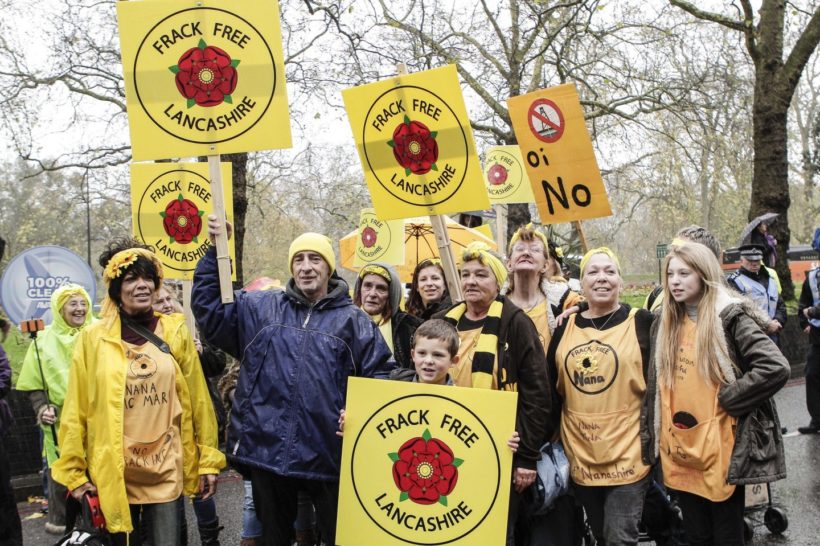

By KAREN MAKUCH & MIRIAM ACZEL
Last weekend, the United Kingdom Government announced a moratorium on fracking, based on evidence from a report by the Oil & Gas Authority (OGA). In this Q&A, Imperial’s Karen Makuch, Senior Lecturer in Environmental Law, and Miriam Aczel, President’s Scholar at the Centre for Environmental Policy, consider what led to the ban, and what it might mean for the UK energy sector going forwards.
What is fracking and why the fuss?
Fracking – also known as hydraulic fracturing or shale gas extraction – is a technical process that injects chemicals and water into the earth under high pressure to fracture shale rock and release oil and gas. Until recently, the UK Government championed fracking in the United Kingdom, saying it could provide the UK with “greater energy security, growth and jobs”, and “could be an important part of our transition to a low carbon future”. Those who have supported it in the UK also point to the economic success of the fracking industry in the United States. However, fracking is hugely contentious – largely on environmental grounds – and there has been widespread public opposition to fracking in the UK for some eight years.
The US is often cited as a ‘success story’ for shale gas, with other countries hoping to emulate their economic gains from fracking. What are the differences between the UK and US?
While the carbon emissions of fracking are arguably the same in both countries, the local impacts vary hugely due to geological and population variations, particularly in England, which is amongst the most densely populated countries in Europe. Fracking sites in the US tend to be remote from where people live and work. Where they are proposed in populated areas, they are generally opposed. New York banned fracking while California did not – on account of population density and environmental and health impacts.
In addition, economic incentives vary in the jurisdictions. In the US, mineral rights often accrue to the landowner, so private property owners can lease the subsurface of their land and make large profits, both from payments for allowing firms to drill under their land, and royalties from shale oil or gas collected. Conversely, in the UK (similar to many other countries, such as France) mineral rights below the depth of 500m are property of the Crown. So, there is a great deal of variation in the financial incentives. While there have been plans to invest some of the royalties back into local communities, the financial return for private companies operating in the UK as opposed to the USA would be much lower.
Furthermore, a recent study found significant differences in public perceptions of shale gas-based energy in the UK and the US. In the US, 43% of respondents associated shale gas withclean energy, and 55% with cheap energy. On the other hand, in the UK, only 25% of respondents associated shale gas with clean energy, and 43% with cheap energy.

Is fracking as scary for health and the environment as opponents say?
Any environmentally invasive process has the potential to negatively affect wildlife and human health – and fracking is no exception. Fracking can have a considerable impact on the local environment by producing noise, dust, and air pollution from the extraction site and plant vehicles, which may in turn exacerbate respiratory problems. Fracking also uses a huge amount of water and ‘frack fluids’, which may contaminate groundwater. Notably, there have also been more earth tremors that breach the UK government’s earthquake limits in areas around fracking sites. All of this can affect local property prices and peoples’ quality of life, including mental health.
Evidence from the US and the Netherlands has highlighted many of these impacts on local communities. For example, huge damage to properties in Groningen in the Netherlands has been attributed to years of drilling – and more recently fracking – for gas; and fracking has contaminated groundwater supplies in some areas of the US. However, further research is needed to fully evaluate the environmental and social impacts. Many studies extrapolate data from the US to estimate impacts in the UK. However, variations in the availability of data, and the ways that research studies are conducted, means we cannot compare like-for-like. We do not have a one-size-fits-all measure of impacts.
What about the climate – isn’t shale gas a lower-carbon energy source?
Fracking has been described as a way to “wean ourselves off carbon”, by using natural gas rather than coal. However, the UK has already made huge progress in reducing its coal consumption – in the third quarter of 2019, coal and oil combined generated less than 1% of UK electricity. As such, the argument of using gas to replace coal is virtually obsolete.
The real question then is where the gas comes from – fracking in the UK, North Sea gas or imported Liquefied Natural Gas (LNG). Studies claim that producing shale gas through fracking creates more greenhouse gas emissions than conventional gas production. Similarly, while carbon dioxide emissions may not be much greater than those from conventional oil and gas, there are considerable methane emissions, a potent greenhouse gas that exacerbates global warming and ozone depletion in the short term, with some saying that fracking for gas produces more methane than drilling for gas.
Earlier this year, then-Prime Minister Theresa May committed the UK to net zero carbon emissions by 2050. To continue with fracking arguably goes against this drive to cut emissions, and against the recommendations of the UK Committee on Climate Change. Furthermore, public opposition to fracking may be attributed to its visibility. Drilling for North Sea gas, for example, is out of sight and out of mind, and is arguably not so much on the radar as an environmental concern.
What is the rationale behind proposed bans on new fracking in England?
The first thing to note is that the halt to fracking is not an outright ban, but a moratorium. It keeps the door open to future use of the technology – even though the Oil & Gas Authority report cites the risks associated with fracking of earth tremors and disruption to local communities.
Fracking has been banned in Scotland since 2013, and the Welsh Government has opposed fracking since 2015. In England, there is currently only one licensed fracking site (to Cuadrilla, a subsidiary of Australian mining group AJ Lucas) at Preston New Road, Lancashire. Considerable human resources and taxpayer’s money has been spent on policing this site – a report from the National Audit Office cites a figure of £32 million of taxpayers money. In 2018, Cuadrilla reported just 29 full-time employees and a profit drop of a third. These low economic returns, coupled with the current scientific evidence, the risk from tremors, and the strength of public protest, suggest that a moratorium is sensible. It provides a lull in which to develop a more robust regulatory regime that governs fracking sites on a case-by-case basis. In the event that the moratorium is later lifted, there needs to be environmental, social and economic impact assessments, carried out by independent third parties at sites where fracking is planned – and a publicly accessible database of findings available for comparative and accountability purposes.
So, what’s next?
Cuadrilla has said it hopes to overturn the moratorium. There are those that say a halt to fracking is an adverse move, arguing that we need investment in fracking to secure jobs, especially in local communities that have lost their core industries. However, a more sensible and sustainable investment would be in renewables infrastructure and the employment opportunities this would bring. October 2019 saw renewables – windfarms, solar panels and renewable biomass plants – provide more energy to UK consumers than fossil fuels. The UK now has an opportunity to build on this success and leapfrog over fracking straight to renewables, setting a good example to its own citizens and the rest of the world. This is where efforts ought to be focused.
Read more from Karen and Miriam in their paper: Shale, quakes, and high stakes: regulating fracking-induced seismicity in Oklahoma, USA and Lancashire, UK, Case Studies in the Environment, (Aczel, M., Makuch, K., Case Studies in the Environment, 2019: https://dx.doi.org/10.1525/cse.2018.001719)
Editor’s note: this article originally appeared on the Grantham Institute for Climate Change‘s blog at https://granthaminstitute.com/2019/11/12/fracking-qa-the-background-the-ban-and-whats-coming-next/
Karen Makuch is Senior Lecturer in Environmental Law & Energy Law in the Centre for Environmental Policy.
Miriam Aczel is a President’s Scholar PhD Candidate at Imperial College London’s Centre for Environmental Policy. Her research focus is on international energy science and policy, with a focus on mitigation of environmental and health impacts of shale gas. She is also co-founder and co-director of the Amir D. Aczel Foundation for Research and Education in Science and Mathematics, a nonprofit based in Cambodia.
Miriam is Director of Communications and blog editor for Leaders in Energy.



Leave a Reply